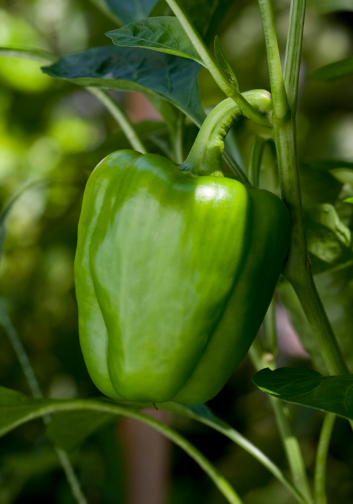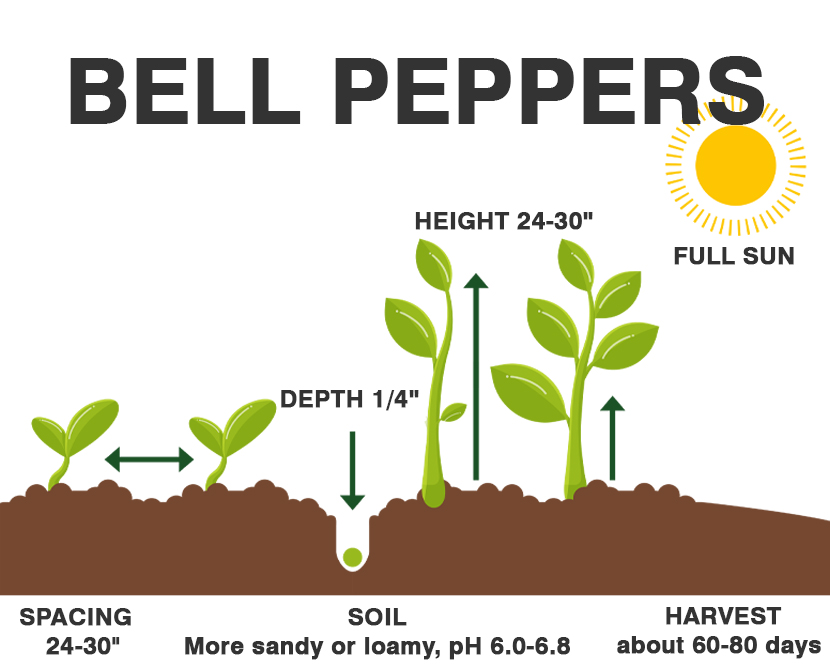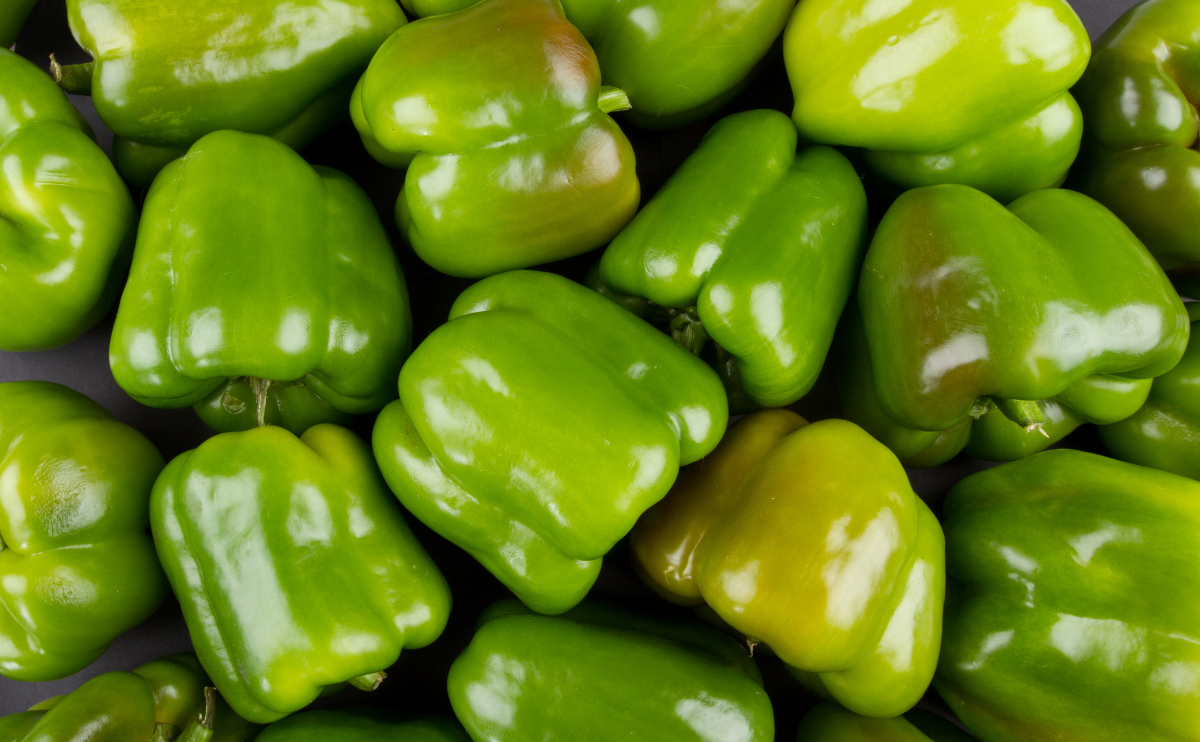The bell pepper (also known as paprika, sweet pepper, pepper, or capsicum ), is the fruit of plants in the Grossum Group of the species Capsicum annuum. Cultivars of the plant produce fruits in different colors, including red, yellow, orange, green, white, chocolate, candy cane striped, and purple. Bell peppers are sometimes grouped with less pungent chili varieties as “sweet peppers”. While they are fruits—botanically classified as berries—they are commonly used as a vegetable ingredient or side dish. Other varieties of the genus Capsicum are categorized as chili peppers when they are cultivated for their pungency, including some varieties of Capsicum annuum.
Peppers are native to Mexico, Central America, and northern South America. Pepper seeds were imported to Spain in 1493 and then spread through Europe and Asia. The mild bell pepper cultivar was developed in the 1920s, in Szeged, Hungary. Preferred growing conditions for bell peppers include warm, moist soil in a temperature range of 21 to 29 °C (70 to 84 °F)

| Botanical Name | Capsicum spp. (mostly C. annuum) |
| Common Name | Hot pepper, chili pepper, chili |
| Plant Type | Herbaceous perennial; usually grown as an annual |
| Size | 1 to 5 ft.; 1- to 3-ft. spread (depends on variety) |
| Sun Exposure | Full sun |
| Soil | Rich, moist, well-drained |
| Soil pH | Slightly acidic (6.0 to 6.8) |
| Native Area | Southern North America and northern South America |
| Hardiness Zones | 9 to 11 (usually grown as annuals) |

When to Plant?
This will be determined by your planting zone. There is a final frost date for each area. As a result, you can plan your gardening activities around this date. Check our Frost Dates Across North America: First & Last Frost Dates Chart. However, the date will not be the same for every plant.
How to Plant
As soon as seedlings emerge, provide plenty of light on a sunny windowsill or grow seedlings 3-4 inches beneath fluorescent plant lights turned on 16 hours per day, off for 8 hours at night. Raise the lights as the plants grow taller. Incandescent bulbs will not work for this process because they will get too hot. Most plants require a dark period to grow, do not leave lights on for 24 hours.
Seedlings do not need much fertilizer, feed when they are 3-4 weeks old using a starter solution (half strength of a complete indoor houseplant food) according to manufacturer’s directions.

If you are growing in small cells, you may need to transplant the seedlings to 3 or 4-inch pots when seedlings have at least 3 pairs of leaves before transplanting to the garden, so they have enough room to develop strong roots.
Before planting in the garden, seedling plants require being “hardened off”. Accustom young plants to outdoor conditions by moving them to a sheltered place outside for a week. Be sure to protect them from wind and hot sun at first. If frost threatens at night, cover or bring containers indoors, then take them out again in the morning. This hardening-off process toughens the plant’s cell structure and reduces transplant shock and scalding.
Bell peppers are very high in vitamin C, with a single one providing up to 169% of the RDI. Other vitamins and minerals in bell peppers include vitamin K1, vitamin E, vitamin A, folate, and potassium.
Fresh, raw bell peppers are mainly composed of water (92%). The rest is carbs and small amounts of protein and fat.
Peppers are very colorful when in full fruit and combine well with green herbs, okra, beans, and cucumber fences in the garden bed.
Companions – tomatoes, parsley, basil, and carrots in your home vegetable garden. Don’t plant them near fennel or kohlrabi.
How to Cultivate
To get an early start with your pepper plants, particularly in the North, cover the prepared bed with a dark-colored polyethylene mulch at least a week before transplanting. This will heat the soil beneath and provide a better growing condition for young pepper plants. The mulch will also help the soil retain moisture throughout the season as the pepper plants grow.
Prefers well-drained, fertile soil high in organic matter, pH 6.0 to 7.5. Can tolerate slightly alkaline soil. Prefers plentiful, consistent moisture. Can tolerate drought, but the quality and flavor of leaves suffer.
Prepare the bed by turning the soil under to a depth of 8 inches. Level with a rake to remove clumps of grass and stones.
Dig a hole for each plant large enough to amply accommodate the root ball. Carefully remove the plant from its pot and gently loosen the root ball with your hands to encourage good root development.
Fill the planting hole with soil to the top and press the soil down firmly with your hand, leaving a slight depression around the plant to hold water.
Use the plant tag as a location marker. This is particularly important if you are trying different varieties. It is very difficult to tell which variety is which from the foliage.
Water thoroughly, so that a puddle forms in the saucer you have created. This settles the plants in, drives out air pockets, and results in good root-to-soil contact.
Peppers may also be planted in containers. Use a container at least 18-24 inches wide and deep, and use a commercial potting mix rather than garden soil.
How to Harvest
Like cucumbers and summer squash, peppers are usually harvested at an immature stage. The traditional bell pepper is harvested green, even though most varieties will mature red, orange, or yellow. Peppers may be harvested at any stage, but their flavor doesn’t fully develop until maturity. Fully ripe peppers in multi-colors are delightful in the garden as well as in salads.
Cut the fruit from the plant with a sharp knife or pruners, leaving a small part of the stem attached.
Hydroponics
Germination: Start by germinating your Bell pepper seeds. You can do this by placing them in a moist paper towel or using a seed starting tray. Once the seeds have sprouted, transfer them to your hydroponic system.
pH range: Bell peppers prefer a pH range between 5.5-6.5. You can use a pH meter or test kit to monitor and adjust the pH level of your hydroponic solution.
EC: The electrical conductivity (EC) for Bell peppers is between 1.6-2.4 mS/cm. This measures the total dissolved salts in the hydroponic solution, so it’s important to monitor it regularly and adjust as needed.
PPM: The recommended parts per million (PPM) for Bell peppers is between 1120-1680. This measures the concentration of nutrients in the hydroponic solution, so it’s important to monitor it regularly and adjust as needed.
Humidity: Bell peppers prefer a humidity level between 40-70%. Use a hygrometer to monitor and adjust the humidity level in your growing area as needed.
Light hours: Bell peppers require at least 8-10 hours of direct sunlight or artificial light per day. If you’re growing them indoors, you can use grow lights to provide the necessary light.
Temperature air: The optimal temperature range for Bell peppers is between 70-80°F (21-27°C) during the day and 60-70°F (15-21°C) at night. It’s important to maintain a consistent temperature in your growing area to ensure healthy growth.
Temperature water: The water temperature should be kept between 65-75°F (18-24°C) to promote healthy root growth and nutrient uptake.
With these guidelines, you should be able to successfully grow Bell peppers hydroponically. Good luck!



